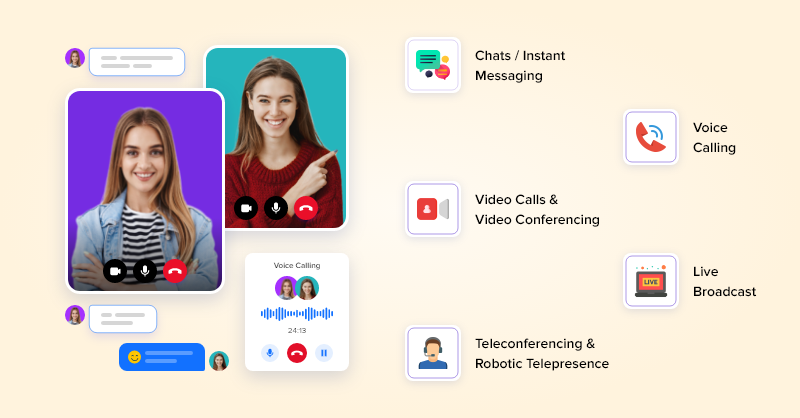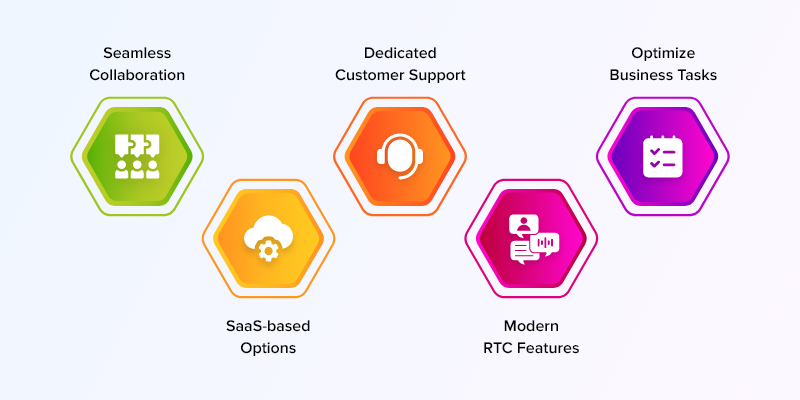What is Real-Time Communication? Its Types & Importance

We all would have heard the phrase, “Patience is a Virtue“. But, would your customers or users be patient enough if you let them wait hours for their queries? No one would as everyone expects an instant response in this fast-paced world. That’s where Real-time Communication (RTC) comes to play!
RTC did not see its evolution overnight. The first technology to enter the race was the telegraph then came the telephone and from it gave birth to a new era of real-time chats.
So, what is real-time communication? Does this type of communication help businesses in anyways? And, are there types of RTC?
All these and how the subsets of real-time communication will change the future will be explained in the post below.
Table of Contents
What is Real-Time Communication (RTC)?
Real-time communications (RTC) are the near-simultaneous exchange of information over any type of telecommunications service from the sender to the receiver in a connection with negligible latency, according to SearchUnified Communications.
Additionally, real-time communications are generally a peer-to-peer mode of communication rather than being called a broadcasting or multicasting mode.
Modes of Real-Time Communication
The RTC data is transmitted between senders and receivers in a straight line in formats like text, voice, or video. This line is referred to as links that consist of nodes within them.
And, RTC data is transmitted in those links in two modes. They are 1. Half Duplex 2. Full Duplex
1. Half Duplex

A half-duplex transmission could be best referred to as a one-way signal between the senders and receivers. Here only users can send or receive messages at a time, but not both.
2. Full Duplex

A full-duplex transmission is the opposite of the above said where users can simultaneously send and receive messages without having to wait.
Next up, we’ll take a look at some of the most common types or model of real-time communication.

- Complete Source Code
- Lifetime Data Ownership
- Deploy on Own Server
Types of Real-Time Communication
The growth of RTC can be seen widely in almost all web and mobile applications as they exist in them as different types.
Below are some real-time communication examples:
- Chats/Instant Messaging
- Voice Calls
- Video Calls & Video Conferencing
- Live Broadcast
- Teleconferencing & Robotic Telepresence

Please note that emails, bulletin boards, and blogs are not the channels of RTC as there exists a delay in transmission and reception. And they come under asynchronous communication mode.
Well, why did RTC see such a boon in life apps? Let us discuss this below.
Why is Real-Time Communication Important?
In today’s fast-paced world, not only does time move fast. Information needs to be shared rapidly, decisions need to be made quickly, products are being developed fastly, and customer queries are being resolved instantly. All these can be made possible with real-time communication technologies. Such benefits have this protocol given to users.
Along with these, the RTC technology has also invaded business operations, in maintaining flawless and seamless peer-to-peer communications, sharing thoughts on common forums, and finally bringing products to fruition.
From what we see, RTCs speak loud in reshaping the business’s work architecture. Has it really done it?
Real-Time Communication For Business Operations
Real-time communication protocols have become a life savior for businesses particularly post the pandemic when the entire world stopped functioning normally. When lockdowns were put into action, the only source for successful work-ops was the remote work option.
And, for that RTC’s types- chats, group calls, and video chats were all used to the max. Furthermore, here’s how real-time communication services were helpful for enterprises.

1. Seamless Collaboration
Businesses started to adopt SaaS-based real-time communication platforms for internal & external collaborations for improving productivity and boosting employee engagement.
2. Dedicated Customer Support
Customers were able to easily interact with support and tech agents via their chat platforms.
3. Optimize Business Task
With channels and forums, team heads can now engage in group calls or chats to complete priority tasks.
4. SaaS-based Option
These days many chat API service providers are offering HRMS SaaS solutions to integrate RTC types to chat platforms. This type of pricing option is helpful for small-scale businesses who are yet to see profits.
5. Modern RTC Features
With top features like screen and file sharing, whiteboards, sharing during conference calls, muting and unmuting, blocking users, and moderations, real-time communication solutions have catered their excellency in varied use cases.
Recommended Reading
Benefits of Real-Time Communication
Without a doubt, everyone on earth is going to believe the fact that real-time communications are a big part of their lives, on both professional and personal grounds. Because they can instantly connect with their friends and families through voice and live video calls or via instant messaging.
However, with these, the other benefits that people sight are:
1. Completely Safe & Sound
Post the Covid-19 pandemic when every business opted for remote work, RTCs saw its boom with video conferencing options. And even now businesses are using group calling methods because of the security behind them. Finally, leading to employee satisfaction and productivity.
2. Faster Delivery
When emails were in existence, the speed of content delivery was very low as the opponent had to wait for hours for the reply. But, with the evolution of RTCs, instant messaging, group video calls, and audio chats were all made possible in just seconds. Due to this, tasks were completed sooner, people got connected quickly, and productivity saw its figures.
3. Instant and Quick Access
With just a swing, individuals made decisions faster with real-time communication. Because the response time from other peers was less and there were no lags in the middle. This led to seamless response management and boosted overall agility.
4. Connection From Anywhere
Remote access is one of the prime benefits of real-time communication that helps people to connect from anywhere in the world. Whether you are in a car or dropping your kids off at school, an RTC mode of communication makes interactions feasible and lag-free.
Next up is.
Future Of Web Real-Time Communication
Throughout the article, we saw the advantages of real-time communication, but as we speak greatly of their pros, this very question gets popped up every time- is there a future for RTC? Or, has it given everything to its users?
The answer is a No. Because, there are a lot of trends happening in this technology, starting from:
- Use of WebRTCs. This technology allows HTML5- enabled browsers to use real-time communications without the need for plugins.
- Another can be seen in the OTT (Over The Top) sector. For example, platforms like Prime and Netflix use the internet to distribute real-time information to customers.
- Yet another trend can be seen in the most developer-friendly chat, voice, and video API provider– MirrorFly. They have come to the forefront of adapting RTC technology to seamlessly establish interactions and collaborations between peers, students, patients, and other users.
Final Thoughts
Firstly, thanks for being patient enough to travel with me this far. And secondly, we must understand that investing in real-time communication tools is always beneficial for businesses. Because they will have a direct impact on customers’ engagement and retention.
So, if you wish to build feature-rich real-time communication apps, we suggest you create an account with MirrorFly and avail of best-in-class features like customizable chat solutions, greater scalability, robust security, low latency, on-premise hosting, and a lot more.
That’s it for now. Did you find this blog post helpful? If you wish to add something new, we would love to learn from you.
Drive 1+ billions of conversations on your apps with highly secure 1000+ In-app Communication Features.
Request Demo200+ Happy Clients
Topic-based Chat
Multi-tenancy Support

Frequently Asked Questions (FAQ)
Real-time messaging is one of the most convenient and efficient ways of communication that allows two or more parties to exchange data in real time with minimal or no delays.
A real-time message can either be a simple chat message, a stock-ticker update, or an IoT sensor reading. And, some of the most popular real-time messaging apps are WhatsApp, Slack, Facebook, and WeChat.
Yes. Chatting that is also known as internal chats or online chats is a form of real-time communication that enables the sender and receiver to send texts, audio, or video messages in real-time without delays. Besides these, other forms of real-time communication include video conferencing, live streaming, and many others.
Real-time and two-way communication is a type of communication where two parties (sender and receiver) are involved in the transfer of messages, audio, and video calls in real-time. It also means that both members of the conversation must be able to engage with each other and respond to texts immediately.
Examples of 2-way real-time communication include video calls, live streaming, video conferencing, and more.
Messaging and real-time communication differs in their characteristics and use cases. While messaging is asynchronous, meaning the sender and receiver can send messages or calls with delays and there is no requirement for instant feedback.
Whereas, real-time communication is a type of data communication that happens in real time with instant responses from both parties. It is a synchronous type of communication and the most common examples are video calling, video conferencing, and others.
The commonly used protocol for real-time communication is RTP (Real-time Transport Protocol). RTP is designed in such a way that it enables the transmission of high-quality real-time audio and video data over IP networks with ultra-low latencies and minimal packet loss. It achieves this with certain features like time stamping, jitter control, and sequencing.
Further Reading
- How to Build A Flutter Video Call App in 2025?
- How to Build a React JS Video Chat App in 2025?
- How to Build an Android Voice and Video Calling App Using Java?
- Communication APIs: Top 7 In-app Chat, Voice & Video APIs
- WebRTC Video Call API: The Definitive Guide